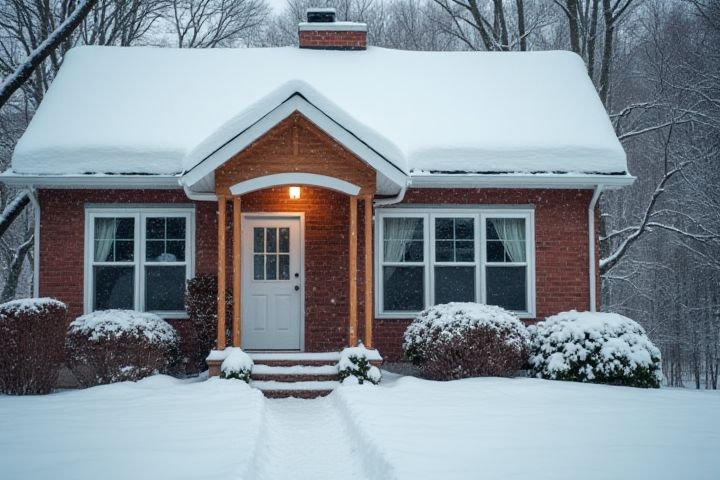
Start by sealing any gaps around windows and doors to prevent drafts, using weather stripping or caulk as necessary. Insulate exposed pipes in unheated areas to minimize the risk of freezing, which can lead to costly repairs. Check your home's heating system; replace filters and consider a professional inspection for optimal performance during colder months. Insulate your attic and basement to maintain energy efficiency, ensuring your living spaces stay warm while reducing heating costs. Lastly, inspect your roof and gutters, clearing debris to prevent ice dams from forming and causing water damage.
How To Winterize Your House
Insulate pipes
To effectively winterize your house, prioritize insulating pipes, as exposed plumbing is vulnerable to freezing. Use foam pipe insulation sleeves for better thermal resistance; they typically come in various sizes to fit different pipe diameters. Ensure that both hot and cold water pipes, especially those in unheated areas like attics or basements, are adequately covered. Schedule this task before temperatures drop below 20degF (-6degC) to prevent costly damage and disruptions to your water supply.
Seal drafts
Seal drafts by inspecting windows and doors for gaps that could allow cold air to infiltrate your home. Utilizing weatherstripping materials, such as foam tape or adhesive-backed felt, can effectively block these openings, enhancing energy efficiency. According to the U.S. Department of Energy, sealing air leaks can save you up to 20% on your heating bill during the winter months. For added protection, consider applying caulk to cracks in the exterior walls, which can further minimize drafts and maintain a cozy indoor environment.
Clean gutters
Cleaning your gutters is essential for effective winterization, as clogged gutters can lead to ice dams that damage your roof and siding. Ensure you remove leaves, twigs, and debris, using a sturdy ladder and gloves for safety; consider using a garden hose to flush out stubborn blockages. A clean gutter system enhances water flow, preventing excess moisture build-up and reducing the risk of leaks during the freeze-thaw cycle. Regularly inspect your gutters, aiming for maintenance at least twice a year, to protect your home's structural integrity and avoid costly repairs.
Check heating system
Examining and servicing your heating system is essential for effective winterization of your home. Begin by inspecting the furnace or boiler for any worn-out components, ensuring all filters are clean and replaced if necessary to maintain optimal airflow. You should also consider having a professional technician perform a thorough system check to identify and resolve any issues before the cold weather sets in. Adequate heating not only keeps you comfortable but also prevents potential damage to pipes and structures caused by freezing temperatures.
Protect outdoor faucets
To winterize your house effectively, start by protecting outdoor faucets, which are vulnerable to freezing temperatures. Consider installing insulated covers or foam pipe insulation, which typically costs around $5 to $15 each. Ensure to shut off the water supply to these faucets and drain any remaining water to prevent ice buildup. For optimal protection, leave the faucet open slightly to allow any residual water to expand without causing damage when it freezes.
Weatherstrip doors
Weatherstripping doors is crucial for enhancing energy efficiency during winter months. Properly installed weatherstripping can reduce heat loss by up to 30%, lowering your heating bills. When selecting materials, opt for options like adhesive-backed foam, V-strip, or door sweeps, as they each provide different levels of insulation and durability. Ensure a tight seal by checking for drafts with a candle or flashlight, and replace any worn or damaged weatherstripping to keep your home warm and comfortable.
Install storm windows
Installing storm windows can significantly enhance your home's energy efficiency during winter months. By reducing heat loss by up to 50%, storm windows serve as an additional barrier against cold air and drafts. Properly positioned storm windows can lower your heating costs by 10% to 15%, making them a wise investment. Ensure the frames are securely fastened, and check for any gaps to maximize thermal insulation and protect against winter weather.
Test smoke detectors
Testing smoke detectors is a crucial step in winterizing your house, ensuring your home remains safe during the colder months. You should check each detector by pressing the test button, which should emit a loud alarm indicating the device is functioning correctly. Ideally, replace any non-working units or expired batteries every six months--this aligns well with daylight saving time changes. Remember that a properly operational smoke detector can increase your family's safety during potential fire emergencies, making it an essential part of your winter preparations.
Trim tree branches
Trim tree branches that are close to your house to prevent potential damage from heavy snow or ice buildup during winter storms. Assess the proximity of branches to your roof and siding, ensuring they are at least 10 feet away to reduce the risk of falling debris. A proper trimming reduces the likelihood of water infiltration and mold growth, as well as cuts down on the chances of rodents using the branches to access your home. Regular maintenance, ideally completed by late fall, keeps your home safe and secure throughout the winter months.
Store outdoor furniture
To effectively winterize your house, begin by thoroughly cleaning and storing your outdoor furniture. Ensure all items are dry to prevent mold and decay; consider using protective covers for added insulation. Organize your storage space to keep patio furniture stacked or stored in a designated area, optimizing the protection against harsh weather elements. By properly winterizing your outdoor furniture, you can extend its lifespan and maintain its appearance for future seasons.
